"This article was translated with the help of an AI translation tool from an article published in the August issue of Korea's monthly magazine, < Monthly Chosun> ." 소프트웨어가 삼켜버린 자동차, SDV
Written by : Park Jeonggyu, adjunct professor at KAIST Graduate School of Technology Management
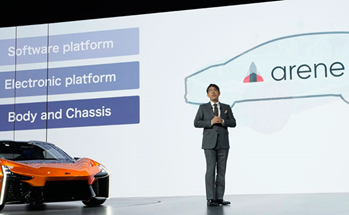
In 2011, a column titled “Why Software is eating the world?” became a hot topic. This article, published in the Wall Street Journal, is about a company called 'Netscape'. It was written by Marc Andreessen, who made a name for himself by developing a web browser . He predicted that software (SW) companies are threatening existing companies in the fields of film, agriculture, and defense, and that similar phenomena will occur in other fields. Now, a dozen years later, as he predicted, software is rushing in with a momentum that threatens to devour automobiles whole.
In the past, automobiles were a traditional mechanical industry. Car manufacturers have created muscular vehicles that run like horses and bulls. Afterwards, with the development of the electrical and electronic industries, microchips began to be installed in mechanical parts to control the minute movements of machines. It's like a kind of autonomic nervous system that controls muscles. From an industrial perspective, it can be seen as a convergence of the machinery industry and the electronics industry. Of course, even at this time, the software existed in the form of a built-in microchip.
However, now vehicles are equipped with high-performance computers (HPC), and the functions that vehicles provide to customers vary depending on the software running on them. We have entered an era where vehicle software is updated wirelessly, just like a smartphone. We call this a Software Defined Vehicle (SDV). The automobile industry is currently transitioning from machinery to electronics and now to software (SW).
Automotive product development process
In 2020, the president of Toyota Motor Company declared ‘software first’. In October last year, existing software-related organizations were merged and a new 'Digital Software Development Center' was established. Hyundai Motor Company also announced that it would convert all vehicle models to SDVs and conducted a major reorganization of its research center early this year. Let's look at the meaning of the terms SDV and software first, which are currently hot topics in the automobile industry, and consider the challenges in future vehicle development.
Before explaining SDV (Software Defined Vehicle), let’s first look at the automotive product development process and characteristics.
This is because the newer the term, the more you have to go back to the basics of the automobile industry to understand it in order to have an unwavering grasp of the concept. To develop a new vehicle, car manufacturers first identify customer requirements and determine the product concept.
For example, let’s say we are developing a new compact car. The product planning department creates a vehicle concept called a ‘compact urban car’ . Then, target values for vehicle functions that will satisfy this concept, such as fuel efficiency and ride comfort, are set. This is called functional design.
To meet the target fuel efficiency, the weight of the vehicle must be reduced and engine efficiency must be improved. The research and development department then carries out work to reduce the weight by 50 kg compared to the existing vehicle and increase the engine's compression ratio by 5%. To reduce vehicle weight, the size of the car can be reduced, or the same size but lighter materials can be used. Also, when reducing the size of a vehicle, work is done to reduce the size of various parts or change the arrangement of parts to secure as large an interior space as possible.
In this way, engineers determine the design parameters of specific structures (parts), that is, the dimensions of the parts and determine the materials, in order to satisfy the functional requirements of the product. This process is called design. Design is the creation of tangible, specific information to satisfy intangible needs (functions), and the output of design is a drawing. In the past, designed information was drawn on paper, but now it is digitized and stored using computers, but the essence is the same. Production is the process of turning this design information into actual objects.
Chain effect of design changes
In the automobile industry, the design process is challenging. A car is basically an object that uses energy to carry people and move 2 tons of heavy objects at high speed. Because it uses energy, it is directly related to environmental problems, and because it moves at high speeds, human accidents can occur. Automotive engineers are beings who live with two problems, the environment and traffic accidents, as if those were their destiny. If the vehicle is only for the safety of the driver, it is possible to build a vehicle like a tank, but the fuel efficiency is naturally poor. If the car body is made of thin steel plates to make it lighter, the car will be crumpled like paper in the event of an accident. In other words, the functions of safety and fuel efficiency conflict with each other.
Many engineers have this conflicting problem, but in the case of automobiles, the degree is more severe than in other products. In particular, when fuel efficiency, safety, and low price are required, design parameters influence each other in a complex way. When a designer changes the dimensions of a part he or she is responsible for, the design of other parts connected to that part must also change. The knock-on effect of these design changes is greater for hybrid vehicles (HEV) than for electric vehicles (BEV). So, when developing a car, we check all the design information together during the development process and then proceed to the next step. This method is called the waterfall method . The name comes from the image of a waterfall moving step by step.
In order to develop a vehicle like this, close cooperation between research and development personnel is required. In terms of athletics, it is similar to a soccer game that emphasizes teamwork. While working at Hyundai Motor Company Research Institute (KARI), the author was dispatched to Namyang Research Institute for one year (November 2014 to October 2015). According to what I observed at the time, the teamwork in the body design department was the best. This may be because close cooperation with colleagues is essential because steel plates must be connected to create a three-dimensional, complete car body structure .
It was previously said that design is the process of specifying the functions required by customers, but honestly, in the case of automobiles, it is not easy to explicitly set the functions that must be satisfied. Therefore, in general, from a mechanical perspective, automobile design focuses on structural design rather than functional design. Even after completing the structure, you may discover functions that you had not thought of before.
From ECU – Engine Control Unit to Electronic Control Unit
Electronic devices began to be introduced into automobiles in the 1960s when automobile exhaust gas regulations were strengthened. In particular , it began in earnest when the U.S. Congress passed the so-called Muskie Act to prevent air pollution in December 1970 . This law required carbon monoxide (CO), hydrocarbons (HC), and nitrogen oxides (NOx) to be reduced by one-tenth within five to six years.
So car manufacturers began using electronic devices that could control values such as engine ignition timing. In 1978, GM introduced the concept of Engine Control Unit (ECU). The ECU looks like a lunch box and contains a printed circuit board (PCB) that connects various electronic devices to each other. Later, as electronic devices were used to control not only engines but also brakes and airbags, ECU became an abbreviation for Electric Control Unit. We have entered an era in which electronic devices control mechanical parts. It was in 1978 that the Department of Control and Measurement Engineering, which once boasted the highest cutoff point in the Seoul National University entrance exam, was established.
Let's look at the characteristics of control here. Control means making an object move in a desired way. Therefore, it is important to clearly define the functions (targets) that must be satisfied. Then, the appropriate control theory is implemented as a logic circuit to achieve the goal. At this time, in the case of electronic devices, the correspondence between the target function and the structure (logic circuit, electronic circuit) that can implement it is relatively clear compared to mechanical devices.
Luxury car , equipped with over 100 ECUs
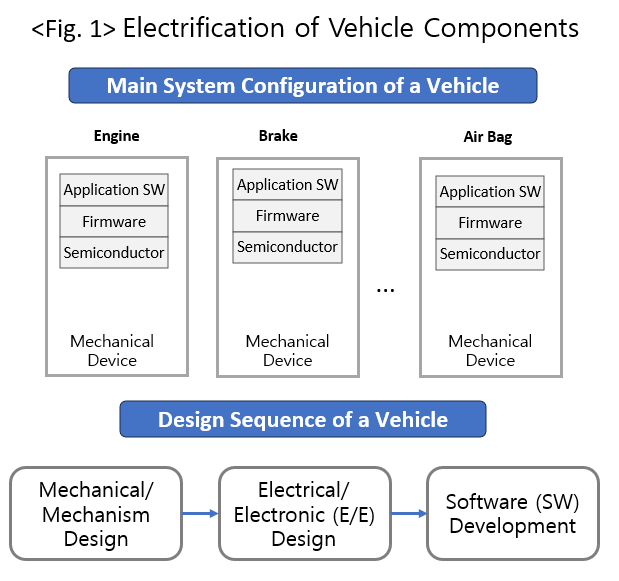
[Figure 1 top] shows the electronic devices inside the mechanical parts and the software embedded within them. The squares in the picture represent large mechanical parts in a car, such as the engine, brakes, and airbags. Although mechanical parts are large, they are controlled , and electronic parts are small, but controlled. Companies that supply parts directly install electronic components such as microchips into mechanical parts and embed the algorithms needed to control them in the form of software . Here, the software is manufactured to fit the specific semiconductor used in each component, so it is difficult to modify.
Despite the inclusion of electronic products, the design of the car proceeded in the order of machinery → electronics → software, as shown in [bottom of Figure 1]. This means that if the machine is not designed, the design of the electronic device cannot proceed, and if the electronic design (e.g., determining semiconductor specifications) is not done, it is difficult to write software. In the case of automobiles, the amount of mechanical parts is overwhelmingly large and the design difficulty is high, so a large number of manpower are deployed. People who manage development projects are usually mechanical engineering majors.
However, as customer needs become more diverse, more and more parts need to be controlled by electronic devices, such as brakes and airbags, as well as engines . In the case of luxury cars, more than 100 ECUs are installed in the vehicle. As the use of electronic components in automobiles increases, the following problems have begun to emerge.
Why does certification exam fraud happen?
First, the amount of software used in electronic devices has increased rapidly. Consider the software used in the ECU. For example, let's say the driver steps on the accelerator to accelerate . Then, the degree to which the accelerator is pressed is detected by a sensor, and gasoline is injected into the engine to ensure good fuel efficiency, taking into account the vehicle speed and the amount of air entering the engine. There are more and more conditions to consider, such as fuel efficiency and emissions.
Therefore, the length of software used to control vehicles has also increased, from about 10 million lines in 2010 to 100 million lines in 2020. And the number of cars with self-driving functions is said to be in the 300 to 500 million range. As the amount of software increases, errors are more likely to occur and development costs increase. The cost share of automotive electronic parts rose to 5% in 1970, 22% in 2000, and 25% in 2010. And it is expected to increase to 50% in 2030. ( Reference: 2023, Harvard Business Case Study, Woven Planet-Designing Software for the Car of the Future)
Second, the vehicle development period has become longer. If a flaw is discovered in the mechanical design, the electronics and software must be redeveloped, or the vehicle must be released without time to complete the targeted functions.
In January of this year, a large-scale certification test fraud case was discovered at Daihatsu in Japan. Among the many fraud cases, one worth noting is the fraud in the certification test that checks whether the airbag operates during a crash test. When the ECU that could control the airbag could not be completed during the certification test, a timer was attached to make the airbag operate. In the end, due to lack of software development time, they first obtained certification through fraudulent means and installed a proper ECU later. This is a representative example showing that it is difficult to develop a vehicle within a set period of time using the current development method.
Musk solves problem by updating software wirelessly
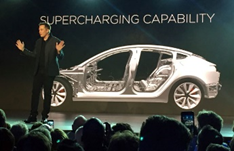
Third, it is difficult to implement new functions. For example, when an obstacle suddenly appears in front of the vehicle, in the past, a person would judge and apply the brakes, and the electronic braking system would detect the road conditions and control the car to stop at the shortest distance. Even if it was electronic, the driver was the final decision-maker who had to apply the brakes. However, now, even if the driver does not apply the brake, the vehicle automatically reduces engine speed, applies the brakes automatically, and for the safety of passengers, a pre- tensioner mounted on the seat belt tightens the driver in advance.
As the number of functions implemented by linking each part increases, it is not easy to respond by simply adding electronic devices to the machine, as shown in [Figure 1]. Now we have entered an era where automobiles require computers with high computational capabilities (HPC). The person who changed the concept of cars through software is Elon Musk. It's Tesla . We often talk about Tesla as a company that manufactures electric vehicles. In fact, Tesla launched the era of popularization of electric vehicles by launching the Model S in 2012 and selling the Model 3 in 2017.
However, Tesla's vehicle is not only an electric vehicle with a battery, but also a vehicle with advanced computing capabilities that can add new functions by updating the software used in the vehicle. There is a representative anecdote that shows this change.
In the United States, there is an automobile evaluation magazine called Consumer Reports. In 2018, this magazine did not recommend purchasing the Model 3, saying that Tesla's Model 3 is lighter than Ford's F-150 pickup truck, but has a longer stopping distance. Elon Musk, who saw this , wrote in his tweet (currently known as Here, OTA stands for Over the Air and refers to a technology that updates software wirelessly. In fact, in just one week, Tesla vehicles shortened the Model 3's braking distance by 6m through a software update like a smartphone ( see: Based on the distance from stopping at 97 km/h). The braking system is one of the main functions of a car, and this problem has been solved by updating the software wirelessly. Ultimately, “ consumer” Report》 changed Model 3 to recommendation.
Driving, braking, and steering functions must be updated
Although it seems like a small incident, this incident shocked existing car manufacturers . Tesla vehicles have already created a software-defined vehicle (SDV) that can update the car's functions through software even before the term SDV was used. Let's look again at the term SDV here. SDV (Software Defined Vehicle) refers to a vehicle that can continuously provide new added value to customers through software updates. However, there is something to be careful about here. First, it is not called SDV just because it has a large amount of software. As mentioned in the previous section, the software length of luxury cars is already around 100 million lines. SDV can only be called SDV if it can provide new services to customers, not the amount of software. Second, the vehicle's basic functions such as driving (Go), braking (Stop), and steering (Handling) functions must be updated. Vehicles that only update navigation and infotainment-related functions are not necessarily called SDVs.

[Figure 2] shows the connection relationship (architecture) of machinery, electronics and software in an SDV vehicle. Existing vehicles have electronic devices within the mechanical device, and software is embedded within them. However, SDV has a vehicle operating system (OS). OS plays a role in allocating and managing the hardware resources required for application SW execution between application SW and hardware (electronics).
Here, the OS is similar to a government function. The government allocates resources such as land and budget to national defense and welfare. Similarly, in computers, operating systems such as Windows and Linux allocate resources such as CPU (central processing unit) and memory to application software such as Word and the Internet. Just as government organizations have the Ministry of Defense and the Ministry of Foreign Affairs, computer operating systems have management systems for each function, such as file system management and memory management. The biggest role of this OS is to separate HW (hardware) and SW (software). This will allow cars to create and install software more easily like computers.
HAL and API
Here, two additional terms need to be understood: HAL (Hardware Abstraction) and API. HAL (Hardware Abstraction Layer) literally means hardware (electronic HW) abstraction. The word abstraction may seem difficult, but we use this concept without realizing it. For example, after working with Word on your computer, you can save it to the hard disk or to an external storage device (USB). Inside a real computer, the two hardware (hard disk and USB) are accessed differently, but the OS (operating system) makes it so that the user cannot feel the difference at all. This is abstraction. Once this abstraction is achieved, software engineers can easily write programs. API (Application Programming Interface) is a type of signaling rule. While driving a car, you use a turn signal to indicate the direction to move, or when you apply the brake, the brake light turns on to signal to the car behind you to slow down. This type of signal is useful as a way to transmit information between entities that have difficulty communicating directly.
The same is true in the software and Internet world. If Naver provides a map and rules for using the map in the form of an API, anyone can view it and create an app using Naver Map on a smartphone. In this way, APIs play an important role in revitalizing the software ecosystem. One of the reasons for the recent rapid growth of Chinese electric vehicles is the standardization policy for automotive APIs. More details will be provided later.
Japan Dispatches Semiconductor Design Engineers to Tenstorrent
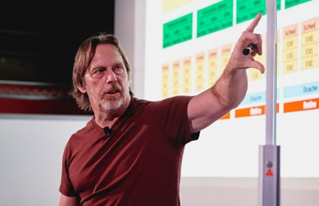
Using a vehicle OS can dramatically improve the existing method in which more than 100 ECUs are complexly intertwined like spaghetti strands. This requires a high-performance computer (HPC) that can integrate multiple ECUs. In this, too, Tesla made a breakthrough. Tesla, which wanted to acquire image data using camera sensors attached to the vehicle and realize automatic driving using artificial intelligence algorithms, developed a computer named FSD in March 2019 and installed it in the vehicle. Here, FSD stands for Full Self Driving. In reality, it cannot drive fully automatically, but Tesla named it FSD anyway, and there are many disputes with regulators over this term.
An FSD computer contains two FSD chips to prepare for accidents or failures of semiconductor chips, and the data processing speed per chip is 36 TOPS (Tera Operations Per Second). 1 Tera means 1012 (10 to the power of 12). In other words, 36TOPS is a semiconductor that performs 36 trillion operations per second.
The person who designed this semiconductor chip is Jim Keller . He founded a startup company called Tenstorrent , a semiconductor design company, in 2016 , and in 2023, Hyundai Motor Company, Samsung Electronics, and LG Electronics invested. Japan is said to select 200 semiconductor design engineers in their 30s and 40s and send them to Tenstorent starting in the second half of this year. We have now entered an era where automobile companies must be directly involved in operating systems, software, and semiconductor design.
software first
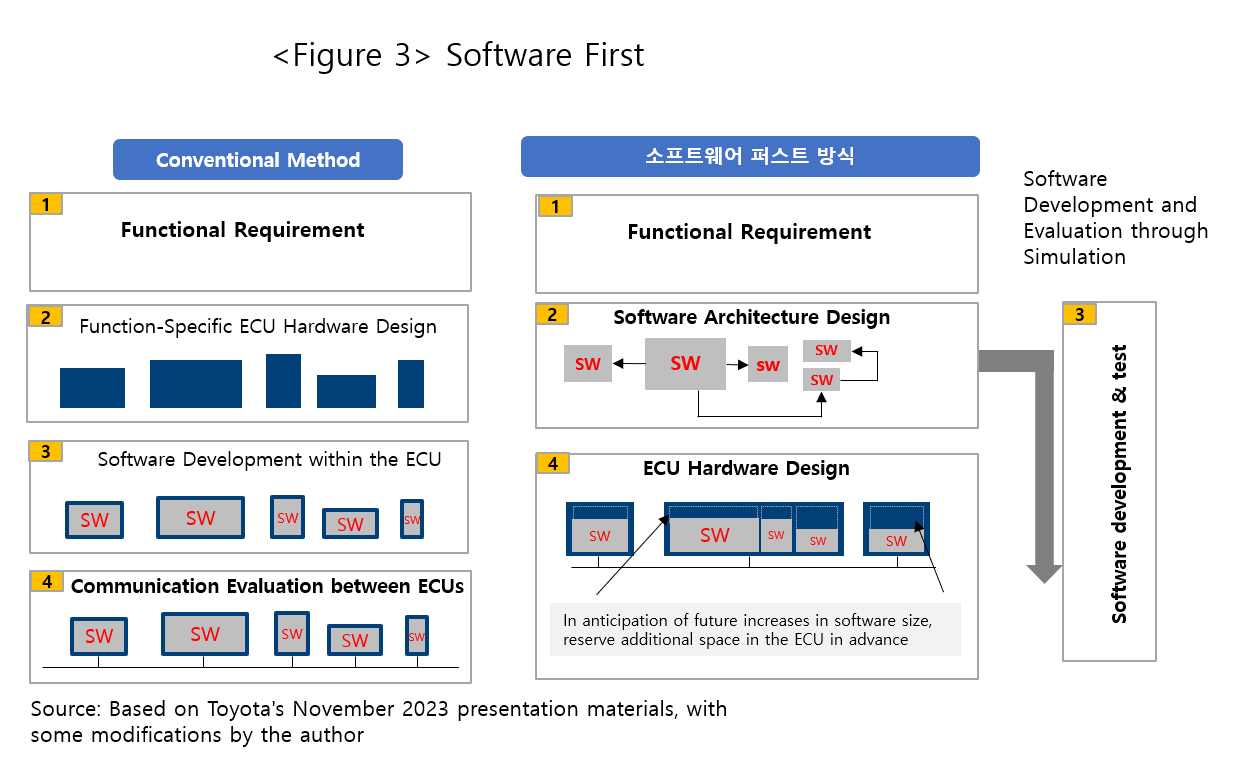
Currently, the term “Software First” along with SDV is popular in the automobile industry. Previously, the existing automobile development method proceeded in the order of mechanical parts → electronic components (ECU) → software, but it was said that this method was becoming increasingly problematic. In particular, the software development period has increased compared to the hardware development period, and the IT industry has developed rapidly, making it difficult to handle the development system of existing automobile manufacturers. So the concept of software first emerged. [Figure 3] is Murata, the person in charge of SDV at Toyota Motor Company in November 2023. This is part of what Kenichi (村田賢一) explains about software first. He completed a doctorate in computer engineering at Keio University , worked on software architecture and OS at Sony from 1996 to 2008, and has been working on software at Toyota Motor Company since 2008. Nowadays, it is common to meet engineers in the automotive field who majored in computer engineering and have practical experience at electronics companies. It proves that times have changed .
According to his explanation, in the existing automobile industry, as shown on the left side of [Figure 3], ① first define the functional requirements needed by the vehicle, ② select the ECU hardware to implement the defined functions, and ③ select the components to be installed in each ECU. The vehicle was developed in the order of developing software and evaluating functions while communicating between ECUs. In situations where the amount of vehicle control required is limited, the ECU capabilities available can be utilized to their full potential. However, it is difficult to secure sufficient software development time using this method. Therefore, the development method was changed to the method shown on the right side of [Figure 3]. First, ① define the functional requirements required by the vehicle, and then ② design and develop the overall structure (architecture) of the software that will satisfy the functional requirements. ③ However, since the ECU hardware does not yet exist, the software is developed through simulation in virtual space . Lastly, ④ Select the ECU hardware into which the SW will be installed and apply it. This will allow ample time for software development. Also, considering that the software will be updated in the future, secure and use an ECU with enough room even if it costs money.
SDV conversion method by country
As explained so far, let's briefly summarize the benefits that will arise if cars are converted to software-defined vehicles. First, product competitiveness can be secured by securing sufficient time for software function development .
Second, as hardware and software are separated, software development becomes easier and software updates can be facilitated, thereby increasing customer satisfaction. Third, software can provide customized services for each user, and car manufacturers can secure profits through software sales even after the vehicle is sold. Now, car manufacturers are making all-out efforts to implement SDV like this.
China, government-led API standardization
The way cars transition to SDVs varies by country. Existing car manufacturers and emerging electric car makers are also showing significant differences. American innovation is, of course, the Superman method. This is a method in which a prominent figure named Elon Musk looks at the problems of existing cars and changes them from the ground up. China is transitioning to SDV with the government's various industrial support policies and the emergence of its own technology-focused startups . Japan conducts thorough research on competitors and makes improvements one by one through discussions between domestic companies and government officials.
Let's look at China first. It is generally known that the development of China's electric vehicle industry is thanks to the Chinese government's unilateral subsidies. According to a Bloomberg article on June 21, the Chinese government provided $231 billion (about 300 trillion won) in support over 15 years from 2009 to last year.
In addition to these subsidies, there were elaborate policies to promote industry. First, China has a policy called ‘exchange of market and technology ’, which in Chinese is called ‘ interchange technology (以市場换技術)’. This was conceived in 1979 and became policy in 1982. And starting in 1984 , it was confirmed as an important policy to accelerate China's technological development . In short, the content of this policy is to secure technology and promote industry through foreign companies by giving them the Chinese market and allowing them to take profits .
It may be a coincidence, but Tesla built a factory in Shanghai in 2019 and began sales in 2020. From then on, China's electric vehicles began to grow in earnest. For example, Chinese electric car maker BYD is known to have established its own unique car development method by making an electric car called Han in 2020.
It's not just this . The Chinese government played a role in revitalizing the automotive software ecosystem. The China Automobile Association (CAAM) recognized that Tesla vehicles are both electric vehicles and software-defined vehicles (SDVs) and promoted an API standardization policy. In December 2020, the China Automobile Association decided on an SDV research group, and from April 2021, automakers and related companies began to participate and define and standardize the APIs needed for SDV. And the API standard was announced four times from October 2021 to November 2022. The standards created in this way are being applied to actual vehicles. Chinese electric vehicle makers BYD and Xpeng are already implementing SDV vehicles like Tesla .
Japan learning from China
It feels like Japanese companies are moving forward step by step. The author participated in the SDV Summit 2024 held in Tokyo, Japan on July 2nd. It was a place where about 300 people gathered to hear government policies and corporate strategies. Those who participated in the seminar were listening intently to the experts' presentations with a significant sense of crisis. The director of the Mobility DX Office of the Japanese Ministry of Economy, Trade and Industry appeared as the first speaker and explained the Japanese government's mobility digital transformation (DX) strategy. What was interesting about this was the policy to standardize and commonize API, which is a method of transmitting information between cars, such as batteries, camera sensors, charging devices, etc. The Japanese government followed China's automobile industry policy.
The second speaker, Professor Takada, director of the Mobility Society Research Center at Nagoya University and an SDV expert, announced that as a result of analyzing the standardized API released by the China Automobile Association, there is a lot of room for future review or improvement. At the same time, they announced that they would launch an organization called 'Open SDV Initiative' with donations received from companies, create API standard specifications for vehicles to take advantage of the strengths of Japanese car manufacturers, and release the standard specifications in March of next year.
Japanese companies are definitely behind compared to Chinese and American startups. However, it seems like I have decided exactly what to learn and follow . Japanese manufacturers' SDVs are likely to be revealed within the next two years. A vehicle created by a joint venture between Honda and Sony is scheduled to be released in 2026, and Toyota also plans to release a vehicle OS called Arene in 2026.
Manufacturing involves creating something, so there are always visible shapes and objects that can be touched. However, because software cannot be seen with the eyes, it is somewhat different from the path taken by Korean manufacturing in the past. Because it is invisible, it is difficult to discuss a common object among organizational members. Software produces results through highly intellectual work, but it has been disparaged because it is something that cannot be touched.
This is one of the reasons why existing car companies are having a hard time creating a new concept car called SDV. So, almost all existing car manufacturers are struggling. In times like these, there is a need to understand the differences between mechanical, electronic, and software engineering and how they work. This is because mutual understanding can create a vehicle that is a fusion of machinery, electronics, and software.
However, unlike in the past, Korea's manufacturing industry is now globalized and specialized. Most of the members have grown while working in their own narrow professional areas and improving work efficiency. However, at a time when machinery, electronics, and software must converge, people who go beyond the boundaries are needed.
Most companies that have quickly succeeded in converting automobiles to SDV are small in size. The smaller the scale, the wider the scope of work. Look at Tesla’s Elon Musk . His scope of activity is so wide that it is difficult to tell whether he is an IT expert or a space launch expert. In times like these, there is a need to discover and nurture engineers with a wide range of work areas .
What is Korea’s automobile policy?
Terms such as software first and SDV are ultimately just a means to satisfy the goal of providing vehicles with good value to customers. Usually, when a new popular term comes along, it's easy to confuse ends and means. Therefore, we must continue to share the results implemented through software with our members so that the value of the implementation can be recognized.
The goal may be grand, but the means must be specific. The Chinese government faced the reality of the Chinese automobile industry and intensively supported electric vehicles. Additionally, API standardization was implemented to create a vehicle software ecosystem. Japan also decided that this was necessary and followed suit. It is time for the Korean government's policy to expand the automobile industry to seek concrete ways to revitalize the software ecosystem, like the automobile industry policies of neighboring countries.⊙

Park Jeonggyu, born in 1968. Graduated from Hanyang University's Department of Mechanical Engineering, Master's degree from Korea Advanced Institute of Science and Technology, Department of Mechanical Engineering from Korea Advanced Institute of Science and Technology, Doctorate from Department of Precision Engineering at Kyoto University, Japan, Visiting Scholar at University of Michigan
/ Researcher at Kia Motors Central Technology Research Institute, Assistant Professor at Department of Precision Engineering at Kyoto University , Japan , LG Electronics Production Technology Institute, Hyundai Motor Company's Automotive Industry Research Institute and overseas Worked in the factory support office and served as an adjunct professor in the Department of Future Automotive Engineering at Hanyang University. Current adjunct professor at KAIST Graduate School of Technology Management
/ Translated books 《Semiconductor Evolution Theory》《Practical Modular Design》《Monozukuri》


댓글
의견을 남겨주세요